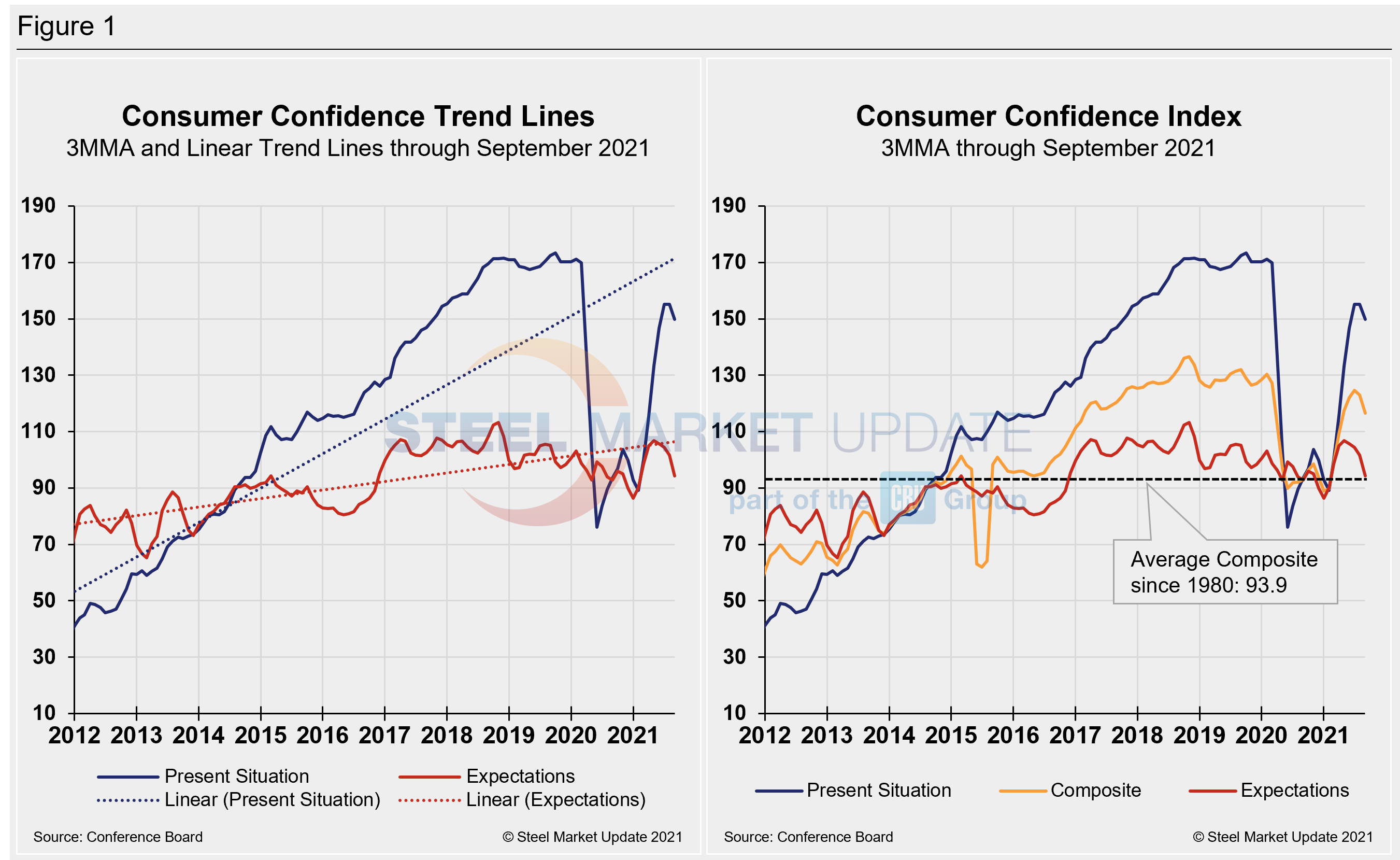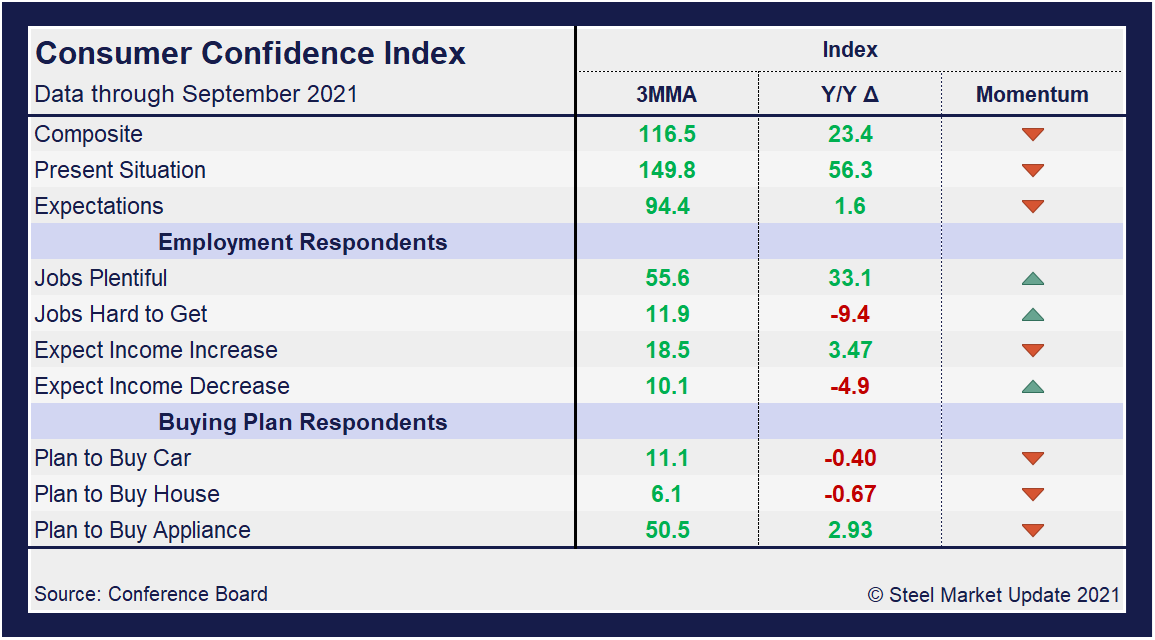Economy

Consumer Confidence Weakens Again in September
Written by David Schollaert
September 29, 2021
U.S. consumer confidence declined for the third straight month in September, following a downward revision for the month prior, according to the latest data from The Conference Board. The September index fell by 5.9 points month on month after slipping 9.9 points in August.
“Consumer confidence dropped in September as the spread of the Delta variant continued to dampen optimism,” said Lynn Franco, senior director of economic indicators at The Conference Board. “Concerns about the state of the economy and short-term growth prospects deepened, while spending intentions for homes, autos, and major appliances all retreated again. Short-term inflation concerns eased somewhat, but remain elevated. Consumer confidence is still high by historical levels—enough to support further growth in the near-term—but the Index has now fallen 19.6 points from the recent peak of 128.9 reached in June. These back-to-back declines suggest consumers have grown more cautious and are likely to curtail spending going forward.”
September’s present situation index, which is based on consumers’ assessment of current business and labor market conditions, saw a 5.5-point downturn month on month to 143.4, following a revised decrease of 8.3 points in August. The expectations index, which is based on consumers’ short-term outlook for income, business, and the labor market, saw the sharpest decline, dropping by 6.2 points to 86.6, the lowest mark since last November.
Calculated as a three-month moving average (3MMA) to smooth out the volatility, The Conference Board’s composite index fell in September to 116.5 compared to 123.1 in August – still well below the pre-pandemic high of 130.4 last February. Despite the negative turn, the index remains higher than the 93.1 seen a year ago. The composite index is made up of two sub-indexes: the consumer’s view of the present situation and his or her expectations for the future. Figure 1 below notes the 3MMA linear trend lines from January 2012 through September 2021 versus the trend lines of all three subcomponents of the index: present situation, composite and future expectations. All three were above the average composite line in October 2020 before falling consecutively through February. The surge from March through June pulled all three indexes above the composite line once again, but all have started to erode rather significantly.

On a 3MMA basis comparing September 2021 with September 2020 in the table below, the present situation has an index reading of 149.8, a dip of 5.4 points from the month prior but still 56.3 points above the year-ago reading. Expectations are at 94.4, down 7.3 from August, and just 1.6 points higher than one year ago. Even though all three indexes show positive gains against year-ago measures from the fallout of the initial COVID-19 wave, the momentum indicator is moving down. Consumers are less optimistic when it comes to current market dynamics.
When comparing current 3MMA totals to the 2019 pre-pandemic year, however, the composite is still down 15.6 points, while the present situation is down 15.2 points. The expectations reading is down 3.8 points in September when compared to the same 2019 period. The consumer confidence report also includes both employment data and some purchase plans and these are likewise summarized in the table below. The color codes show improvement or deterioration of the individual components.
The composite, present situation and expectations indices had been trending up, recovering much of what was lost from the fallout from the global pandemic, but momentum has shifted downward over the past three months. Despite recent contraction, buying plans for autos, homes and appliances are still up on a 3MMA basis, but buying plans for autos and houses are down when compared to year-ago levels, highlighting the momentum shift that has turned and retreated.
The labor market landscape has shifted of late. Job openings continue to rise, but optimism regarding the prospect of increased wages has dipped when compared to the same year-ago period.

People found jobs more plentiful in September but have grown pessimistic when it comes to wage increases. The differential between those finding jobs plentiful and those having difficulty was 42.5 in September, down marginally from 44.4 in August. The measure has easily eclipsed the most recent pre-pandemic high of 35.3 in January 2020, and is a strong rally from the -1.8 seen at the beginning of the year. The differential between those expecting wages to rise versus those expecting wages to fall is presently 5.8, down 2.5 points month on month and down from the recent high of 11.6 in June.
Spending plans for consumer goods as measured by automobiles, homes and appliances had been trending up through June, but started slowing in July. Since then, figures have moved down with consumer goods spending declining. Buying has contracted across all three categories successively in August and September, with consumer spending on autos seeing the most aggressive decrease, falling by 11.6% to 9.9 in September. Appliance buying plans slipped to an index reading of 47.0, while home buying plans edged down to 5.6 in September. These recent dynamics and historical movements are illustrated below in Figure 2.

About The Conference Board: The Conference Board is a global, independent business membership and research association working in the public interest. The monthly Consumer Confidence Survey®, based on a probability-design random sample, is conducted for The Conference Board by Nielsen. The index is based on 1985 = 100. The composite value of consumer confidence combines the view of the present situation and of expectations for the next six months.
By David Schollaert, David@SteelMarketUpdate.com

David Schollaert
Read more from David SchollaertLatest in Economy

ISM: Manufacturing expansion loses steam after two months of growth
US manufacturing activity slowed in March after two straight months of expansion, according to supply executives contributing to the Institute for Supply Management (ISM)’s latest report.

Chicago Business Barometer rose to 16-month high in March
The Chicago Business Barometer increased for the third-consecutive month in March. Despite this, it still reflects contracting business conditions, as it has since December 2023.

Durable goods orders rise again in February
Transportation equipment led the increase, rising 1.5% to $98.3 billion.

Consumer confidence falls for fourth consecutive month
People remain concerned about inflation, trade policies, and tariffs.

Housing starts ticked up in February
Single-family starts last month hit a rate of 1.10 million, a month-over-month increase of 11.4%, census data shows.
